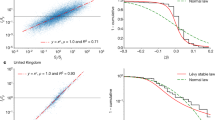Abstract
A set of papers are discussed laying the foundations for a comprehensive dynamical theory of discontinuities in urban population size. Abstracting from the main premise of the papers, which appeared in 1980, a thesis is advanced that an encompassing notion ofdynamic comparative advantages underlies urban growth or decline. It is argued that such a theory is consistent with the notions found in Darwinian evolution. References to classical urban literature are made, linking these models to long-standing views of urban evolution.
Similar content being viewed by others
References
Alonso W (1964) Location and land use. Harvard University Press, Boston
Amson J (1975) Catastrophe theory: a contribution of the study of urban systems? Environ Plan B 2:177–221
Andersson ÅE (1986) The four logistical revolutions. Papers Reg Sci Assoc 59:1–12
Arthur WB (1988) Self-reinforcing mechanisms in economics. In: Anderson PW, Arrow KJ, Pines D (eds) The economy as an evolving complex system. Addison-Wesley, Reading, MA, pp 7–31
Arthur WB (1989) Competing technologies, increasing returns, and lock-in by historical events. Econ J 99:116–131
Boldrin M, Scheinkman JA (1988) Learning-by-doing, international trade and growth: a note. In: Anderson PW, Arrow KJ, Pines D (eds) The economy as an evolving complex system. Addison-Wesley, Reading, MA, pp 285–300
Casetti E (1980) Equilibrium population partitions between urban and agricultural occupations. Geograph Anal 12 (1):47–54
Day RH, Walter JL (1989) Economic growth in the very long run: on the multiple phase interaction between population, technology, and social infrastructure. In: Barnett WA, Geweke J, Shell K (eds) Economic complexity: chaos, sunspots, bubbles, and nonlinearity. Cambridge University Press, Cambridge, pp 253–289
Dendrinos DS (1976) Two applications of catastrophe theory in transportation planning and urban economics. Paper presented at the Annual Meeting of the Regional Science Association, Toronto, November
Dendrinos DS (1979) A basic model of urban dynamics expressed as a set of Volterra-Lotka equations. In: Dendrinos DS (ed) Catastrophe theory in urban and transport analysis. Report No.: DOT/RSPA/DPB-25/80/20. US Department of Transportation, Washington DC, June 1980
Dendrinos DS (1980) Dynamics of city size and structural stability: the case of a single city. Geograph Anal 12:236–244
Dendrinos DS (1992) The dynamics of cities: ecological determinism, dualism and chaos. Routledge, London
Dendrinos DS (with Henry Mullally) (1985) Urban evolution: studies in the mathematical ecology of cities. Oxford University Press, Oxford
Dendrinos DS, Sonis M (1990) Chaos and socio-spatial dynamics. Springer, New York Berlin Heidelberg
Henderson JV (1977) Economic theory and the cities. Academic Press, New York
Isard W (1977) Strategic elements of a theory of major structural change. Papers Reg Sci Assoc 38:1–14
Jacobs J (1969) The economy of cities. Vintage, New York
Krugman PR (1985) The narrow moving band, the dutch disease and the competitive consequences of Mrs. Thatcher: notes on trade in the presence of scale economies. Mimeo, Department of Economics. MIT, Cambridge
Lucas RE Jr. (1988) On the mechanics of economic development. J Monet Econ 22:3–42
Marshall A (1923) Money trade and commerce. Macmillan, London
Mees AI (1975) The revival of cities in medieval europe. Regional Science and Urban Economics 5:403–425
Mumford L (1961) The city in history. Harcourt Brace Jovanovich, New York
Nijkamp P (1983) Technological change, policy response, and spatial dynamics. In: Griffith DA, Lea AC (eds) Evolving geographical structures. Martinus Nijhoff, The Hague, pp 75–98
Papageorgiou GJ (1980) On sudden urban growth. Environ Plan A 12:1035–1050
Pirenne H (1925) Medieval cities (English translation by Halsey FD). Princeton University Press, Princeton
Rosser JB Jr (1991) From catastrophe to chaos: a general theory of economic discontinuities. Kluwer Academic Publishers, Norwell
Thom R (1975) Structural stability and morphogenesis. Benjamin, Reading, MA
Todaro M (1982) Economic development in the third world. 3rd edn. Longman, London
Wheaton W (1974) A comparative static analysis of urban spatial structure. J Econ Theory 9:223–237
Wilson A (1976) Catastrophe theory and urban modelling: an application to modal choice. Environ Plan A 8:351–356
Wilson A (1981) Catastrophe theory and bifurcation. Croom Helm, London
Zeeman EC (1977) Catastrophe theory: selected papers 1972–1977. Addison-Wesley, Reading, MA
Author information
Authors and Affiliations
Additional information
The authors wish to acknowledge helpful comments from Emilio Casetti, Günter Haag, and anonymous referees.
Rights and permissions
About this article
Cite this article
Dendrinos, D.S., Rosser, J.B. Fundamental issues in nonlinear urban population dynamic models. Ann Reg Sci 26, 135–145 (1992). https://doi.org/10.1007/BF02116365
Received:
Accepted:
Issue Date:
DOI: https://doi.org/10.1007/BF02116365




